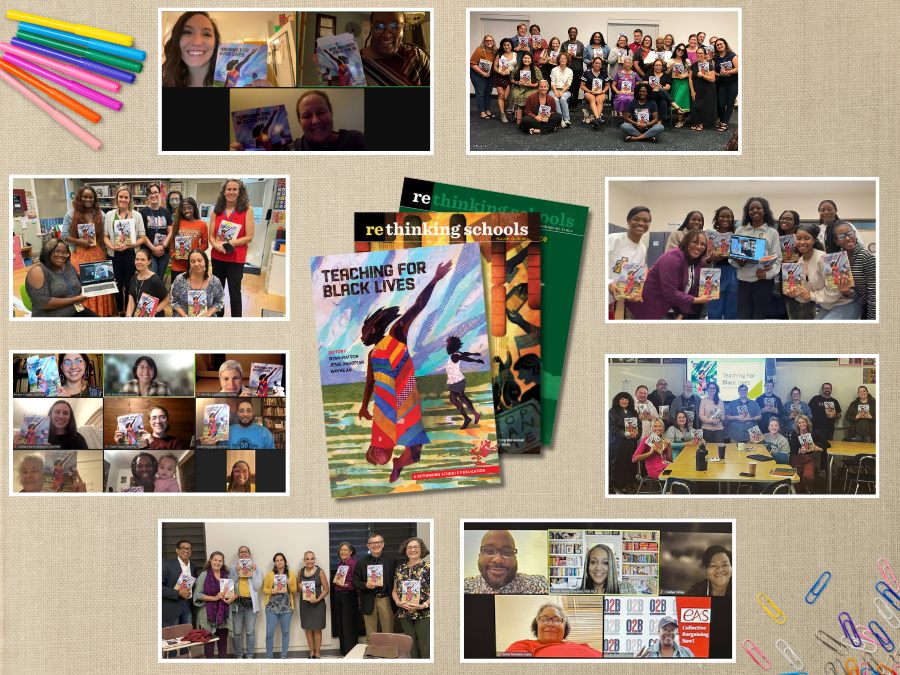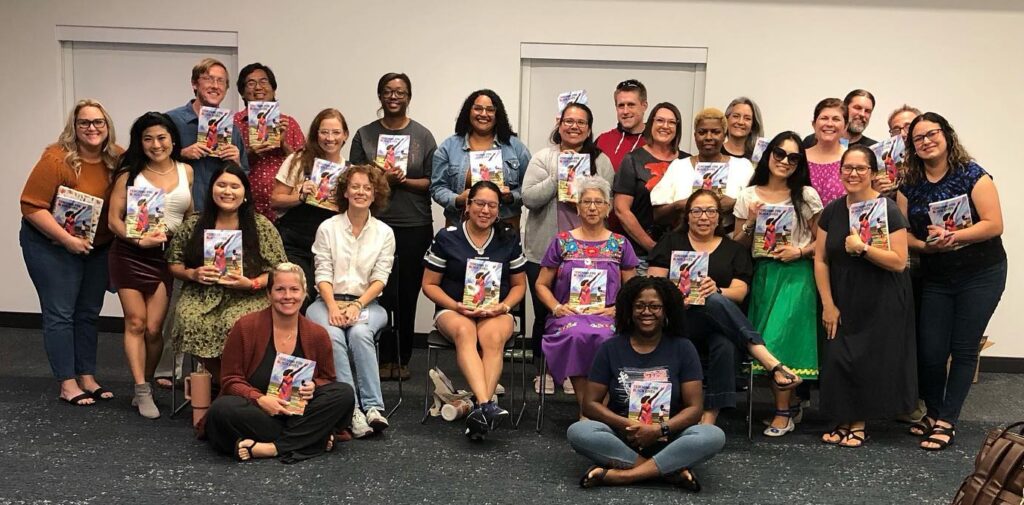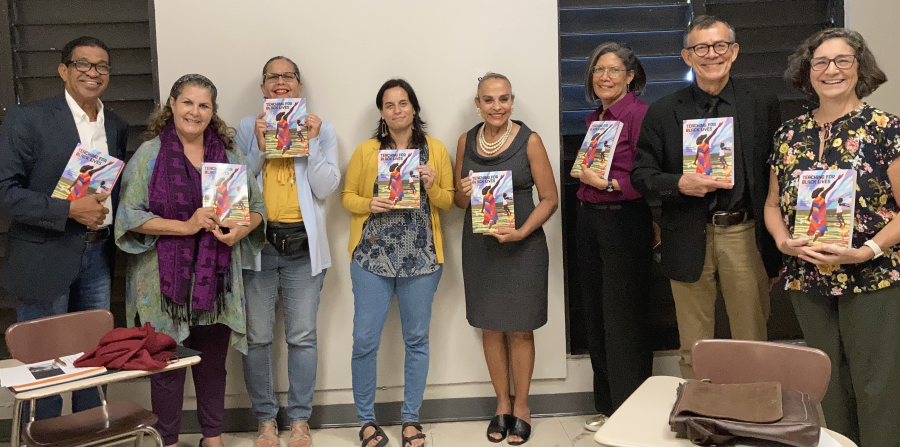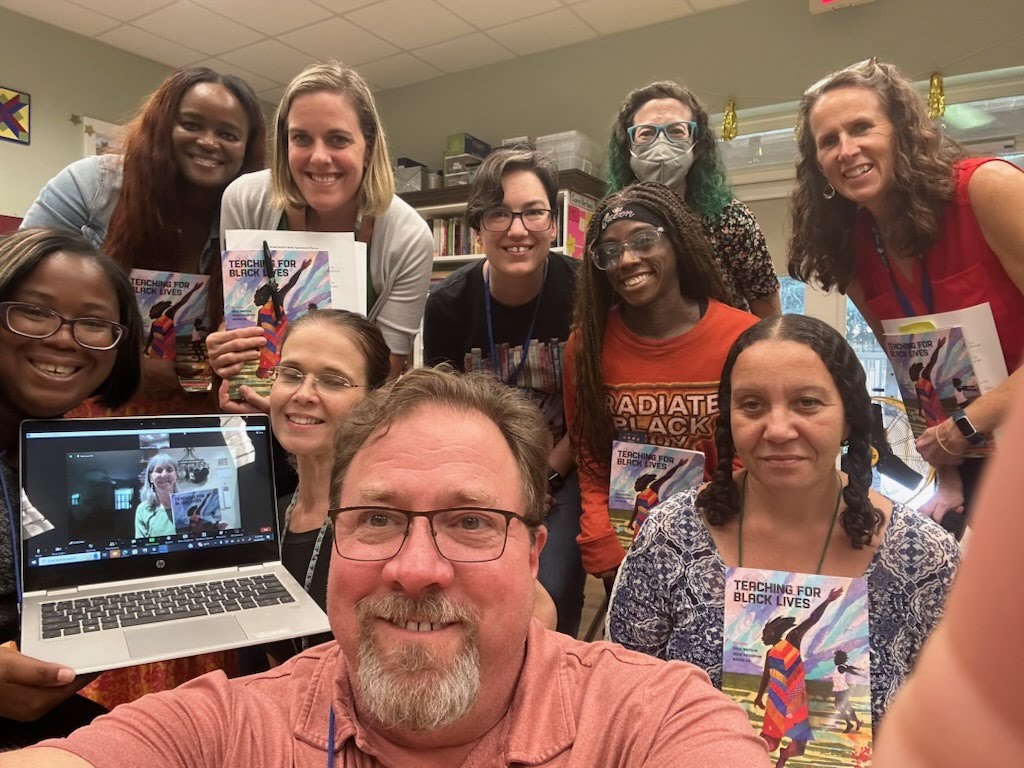
It is exciting to hear stories from the study groups as they report back on their progress mid-school year. Here are highlights from the coordinators.
Study group members are inspired to take action in and out of their classroom. The articles in Teaching for Black Lives give them concrete ideas.
Participants are implementing and adapting lessons, such as “Happening Yesterday, Happening Tomorrow” by Renée Watson, creating spaces for young Black women, and identifying needed policy changes.
Reading stories in the book by teachers motivates study group members to document their own stories. In response, we have scheduled a two-part writing-for-publication workshop.
Here is what coordinators shared about their discussions:
Section 1: “Making Black Lives Matter in Our Schools” sparked conversation around our power as staff. We came to realize that we do have more power and influence to make changes, particularly when it comes to policy, class norms, representation, and enforcement in our building than we thought. We had great discussions on issues that our students have been bringing up and ways we could better support them. We asked ourselves, what are some ways we can stick our necks out for our students? — Katie Davis, academic success coordinator, Omaha, Nebraska
The “Two Sets of Notes” poem by M. K. Asante in Section 1 really hit home for the Black members of our group, not just in relation to their own schooling but also as staff in our school. One of our Black members challenged those of us who are white to continue to amplify the voices of BIPOC staff and to insist on changes that our students need. I am pleased that we have all spoken our truth, white folx have done more listening than talking, and we are solutions-oriented rather than just complaining or listing grievances. — Hillary Self, middle school social studies teacher, Seattle, Washington
Section 1 of Teaching for Black Lives helped us reflect on our school and what we can be doing here, what actions we can take, and how we can turn our work into something that benefits the school and community at large. In particular we focused on changing perceptions to allow Black children to be children, play and be goofy and authentic without being perceived as a threat. — Denver, Colorado
We have been grounding our discussions and work on the identity and restorative justice material. Clint Smith’s “Ode to the Only Black Kid in the Class” from Section 5: “Teaching Blackness, Loving Blackness, and Exploring Identity” inspired me to have students create and share their own odes. It paired nicely with Elizabeth Acevedo’s “Rat Ode” and was a great way to have students reflect on their identities and experiences, praise an aspect of their identity, or even clapback at assumptions. — Sarah Nelson, high school social studies teacher, Bothell, Washington

Study group in San Marcos, Texas
The two richest conversations came out of the meeting where we discussed “How One Elementary School Sparked a Citywide Movement to Make Black Students’ Lives Matter” and the Reconstruction chapter “When Black Lives Mattered.” We are creating inquiry/research groups where we are focusing on areas of interest and writing in small groups, doing some level of action research/participative inquiry in our schools with plans to write up and share the findings. — Rolf Straubhar, associate professor, San Marcos, Texas
The chapters that have had the most impact at this point have been “Space for Young Black Women” and “A Vision for Black Lives.” We have had substantive discussions about how our young Black women are hurting, and how that is cropping up in our school and classrooms and what we can do to better support them. We are talking about finding a leader and creating a group space. — Laura Tucci, Roseville, Minnesota
We read “What Do You Mean When You Say Urban” by Dyan Watson in the shared text and “Letter to My Asian American Students” by Ken Hung in Rethinking Schools Fall 2023 Issue. We talked through the definition of “urban,” what it means to us to teach in an “urban” district, how others perceive this work, and how we can use narrative and storytelling to combat negative and racist stereotypes about our work. — Providence, Rhode Island
We discussed the need to talk about Blackness, not only in classrooms, but as part of the organizational culture. We discussed the possibility of reviewing Human Resources policies on hiring Black people and other minority ethnicities. We planned a possible workshop for professional development on diversity, equity, inclusion, and belonging (DEIB) with emphasis on teaching for Black lives. The purpose of this workshop is to address the needs of Black students and employees. — Margarita Marichal, program director, San Juan, Puerto Rico

Study group in San Juan, Puerto Rico
The first chapter sparked a long discussion about the relationship between Black students and public education. We grappled with how school personnel can take sincere steps toward creating genuinely supportive environments for Black students. This involved imagining what these practices could look like, using Teaching for Black Lives as a starting point, taking stock of the time, talent, and fiscal resources needed to employ these practices with fidelity, and examining the reasons why resources are not currently dedicated to this end. — Blake Marlowe, San Antonio, Texas
We know there are challenges (and challengers) in abundance as we move forward with our goal of sharing true history. Our Teaching for Black Lives study group is navigating how to do that in a way that our colleagues feel supported (we are sharing our district’s equity policies so that everyone knows them well), so that we can build allyship and support when we are confronted (as we know will happen). — Pam Winkler, teacher equity advocate, White Bear Lake, Minnesota
Coordinators shared appreciation for the space and resources we offer in the Teach the Black Freedom Struggle online classes, curriculum workshops, and opening sessions. Here are two testimonials:
I appreciate hearing from experts and people who have first-hand experiences with some of my curriculum. The “Lessons from SNCC” class was amazing, and I appreciated all the resources. It was nice to be in the breakout groups with folx I had been with in other classes. — Hillary Self, middle school social studies teacher, Seattle, Washington

Study group in Tallahassee, Florida
I found the orientation for group coordinators to be really inspiring and was a great springboard into the year. I attended the workshop on the Black working class and gained a new perspective on history. The idea of using Pullman Porter unions as a frame for the Progressive Era and the pressure to eradicate unions in the United States has been formative. — Bryan Williams, middle school social studies teacher and coordinator, Tallahassee, Florida
Participants are enjoying their one-year subscription to Rethinking Schools magazine. Here are comments about favorite articles:
Jesse Hagopian’s article in the current issue “The Growing Attack on Educators” led to a really good discussion on how we each negotiate the hostile political climate of contemporary Texas schools. — Rolf Straubhar, associate professor, San Marcos, Texas
Teaching in Florida, “The Growing Attacks on Educators” and “Fighting for LGBTQ+ Youth and Families” were very interesting to me. I also enjoyed Wayne Au’s and Sohyun An’s articles on Asian Americans, discrimination, wedge issues, and positive history. I’m looking forward to reading the article on Ida B. Wells. — Bryan Williams, middle school social studies teacher and coordinator, Tallahassee, Florida
Our study group enjoyed the issue on debt and schools. The article that stood out was “50 Years Older and Deeper in Debt” because North Carolina schools are always having to contend with underfunding and a crumbling infrastructure. — Greensboro, North Carolina
We had a whole staff Professional Development at the beginning of the school year where we read, “Taking Multicultural, Anti-Racist Education Seriously” and I think everyone was able to take something from it. Our focus as a school was to ensure our curriculum was culturally responsive. This reading helped us understand that there were still things to consider that maybe we had not and to think about the good things we were already doing. — Jennifer Velazquez, high school English teacher, Chicago, Illinois
We appreciate how educators in Teaching for Black Lives study groups make time to read, reflect, and dream of new possibilities for schools and communities. We can’t wait to see what unfolds in the spring of 2024.

